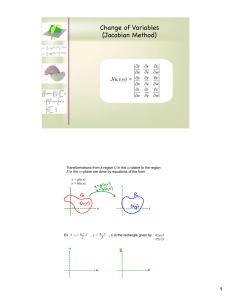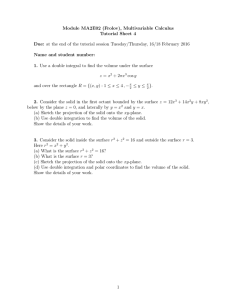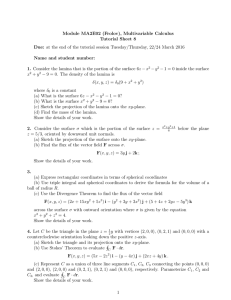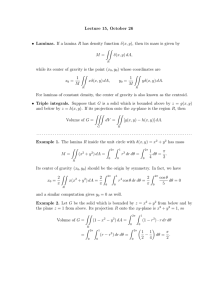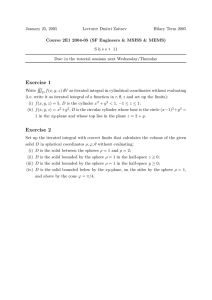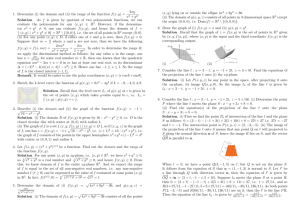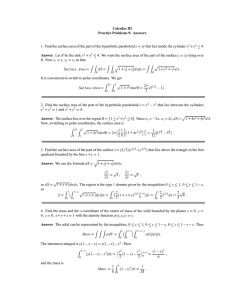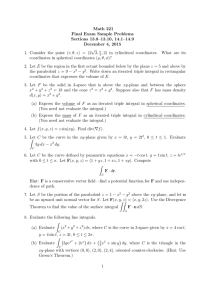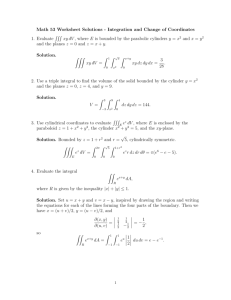January 11, 2005 Lecturer Dmitri Zaitsev Hilary Term 2005
advertisement
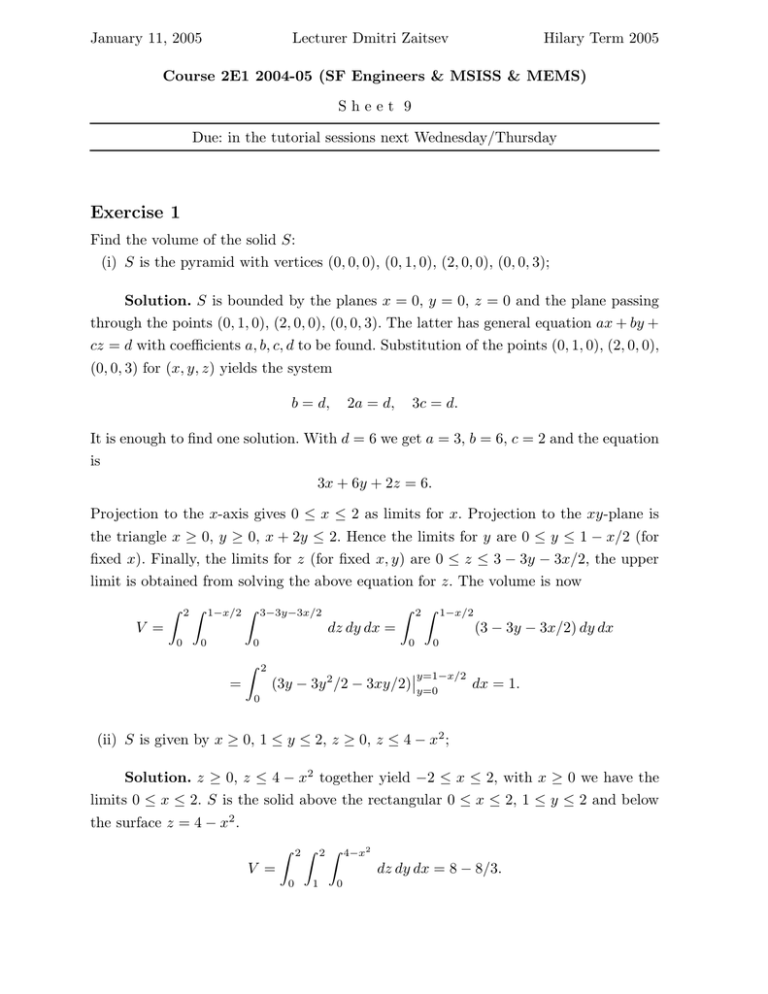
January 11, 2005 Lecturer Dmitri Zaitsev Hilary Term 2005 Course 2E1 2004-05 (SF Engineers & MSISS & MEMS) Sheet 9 Due: in the tutorial sessions next Wednesday/Thursday Exercise 1 Find the volume of the solid S: (i) S is the pyramid with vertices (0, 0, 0), (0, 1, 0), (2, 0, 0), (0, 0, 3); Solution. S is bounded by the planes x = 0, y = 0, z = 0 and the plane passing through the points (0, 1, 0), (2, 0, 0), (0, 0, 3). The latter has general equation ax + by + cz = d with coefficients a, b, c, d to be found. Substitution of the points (0, 1, 0), (2, 0, 0), (0, 0, 3) for (x, y, z) yields the system b = d, 2a = d, 3c = d. It is enough to find one solution. With d = 6 we get a = 3, b = 6, c = 2 and the equation is 3x + 6y + 2z = 6. Projection to the x-axis gives 0 ≤ x ≤ 2 as limits for x. Projection to the xy-plane is the triangle x ≥ 0, y ≥ 0, x + 2y ≤ 2. Hence the limits for y are 0 ≤ y ≤ 1 − x/2 (for fixed x). Finally, the limits for z (for fixed x, y) are 0 ≤ z ≤ 3 − 3y − 3x/2, the upper limit is obtained from solving the above equation for z. The volume is now V = Z 2 0 Z 1−x/2 0 = Z 3−3y−3x/2 dz dy dx = 0 Z 2 0 Z 2 0 Z 1−x/2 (3 − 3y − 3x/2) dy dx 0 y=1−x/2 (3y − 3y 2 /2 − 3xy/2)y=0 dx = 1. (ii) S is given by x ≥ 0, 1 ≤ y ≤ 2, z ≥ 0, z ≤ 4 − x2 ; Solution. z ≥ 0, z ≤ 4 − x2 together yield −2 ≤ x ≤ 2, with x ≥ 0 we have the limits 0 ≤ x ≤ 2. S is the solid above the rectangular 0 ≤ x ≤ 2, 1 ≤ y ≤ 2 and below the surface z = 4 − x2 . V = Z 2 0 Z 2 1 Z 4−x2 dz dy dx = 8 − 8/3. 0 (iii) S is given by x ≥ 0, y ≥ 0, x + y ≤ 1, 0 ≤ z ≤ x2 + y 2 . Solution. Projection to the xy-plane is given by x ≥ 0, y ≥ 0, x + y ≤ 1 and so x-limits are 0 ≤ x ≤ 1 and y-limits for fixed x are 0 ≤ y ≤ 1 − x. Finally, z-limits for fixed x, y are given: 0 ≤ z ≤ x2 + y 2 . S is the solid above the triangular x ≥ 0, y ≥ 0, x + y ≤ 1 in the xy-plane and below the surface z = x2 + y 2 . Z V = 1 0 Z 1−x Z 0 x2 +y 2 dz dy dx = 1/6. 0 Exercise 2 Find area and center of mass (assuming constant density δ = 1) of the bounded region R: (i) R is given by 2 ≤ x ≤ 4, 3 ≤ y ≤ 7; Solution. The area is A= Z 4 2 Z 7 dy dx = 8, 3 the mass is M= Z 4 2 Z 7 δ(x, y) dy dx = 8, 3 the moments are M1 = Z 4 2 Z 7 xδ(x, y) dy dx = 3 Z 4 2 Z 7 x dy dx 3 and M2 = Z 4 2 Z 7 yδ(x, y) dy dx = 3 Z 4 2 Z 7 y dy dx. 3 1 M2 Then the center of mass is the point with coordinates ( M , M ). The evaluation is simple M and is omitted, also in what follows. (ii) R is given by x ≥ 0, y ≥ 0, 2x + y ≤ 2; Solution. The limits for x are found by eliminating it from the given inequalities. We rewrite the last inequality as x ≤ 1 − y/2 and use the second to obtain x ≤ 1. Hence 0 ≤ x ≤ 1 and the last two inequalities give 0 ≤ y ≤ 2 − 2x. Now the area is A= Z 1 0 Z 2−2x dy dx, 0 the mass is M= Z 1 Z 0 2−2x dy dx 0 and the moments are M1 = Z 1 0 Z 2−2x x dy dx 0 and M2 = Z 1 0 Z 2−2x y dy dx 0 1 M2 and the center of mass has the coordinates ( M M , M ). (iii) R is given by y ≥ 0, y ≤ 1 − x2 . Solution. Here, eliminating y, we have 0 ≤ 1 − x2 which yields −1 ≤ x ≤ 1. Hence the area is Z 1 Z 1−x2 dy dx, A= −1 0 1 Z the mass is M= Z −1 1−x2 dy dx 0 and the moments are M1 = Z 1 −1 Z 1−x2 x dy dx 0 and M2 = Z 1 −1 Z 1−x2 y dy dx 0 1 M2 and the center of mass has the coordinates ( M M , M ).
